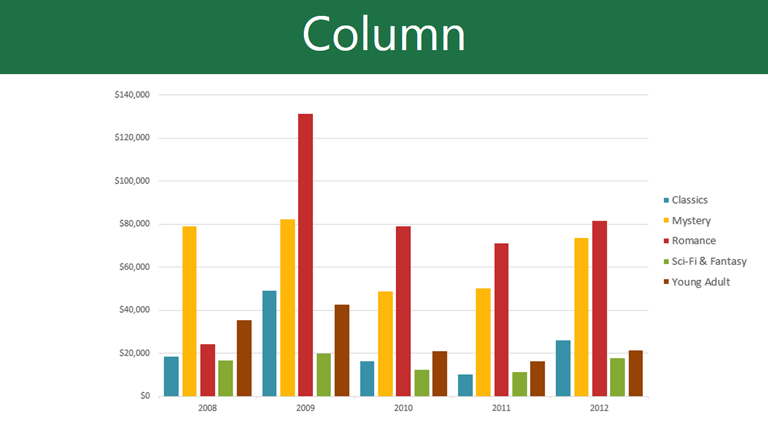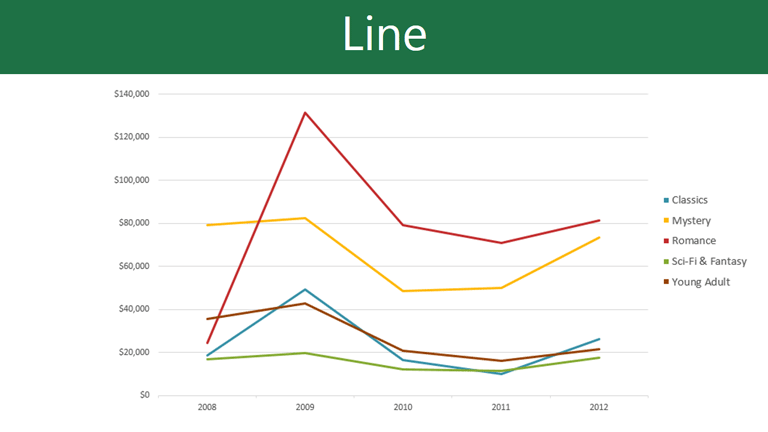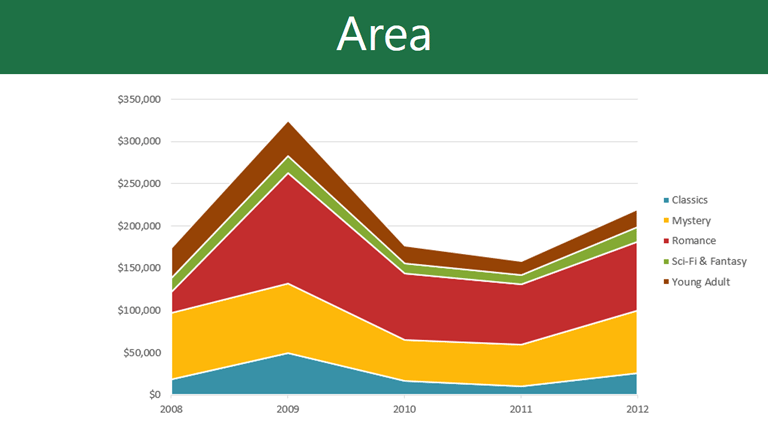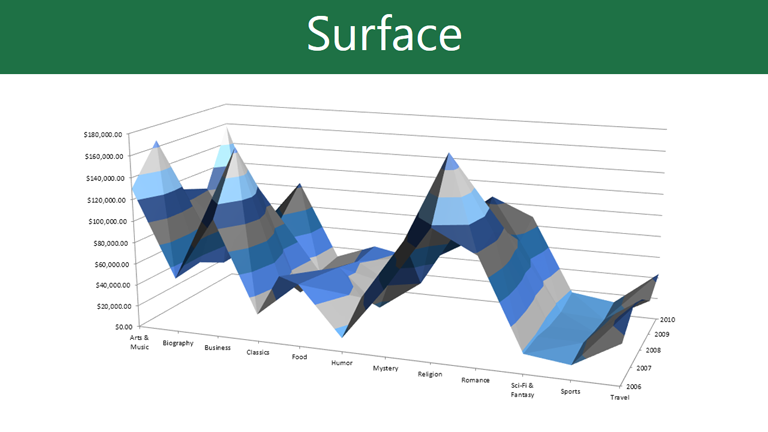PowerPoint 2013
Charts
Introduction
A chart is a tool you can use to communicate data graphically. Including a chart in a presentation allows your audience to see the meaning behind the numbers, which makes it easy to visualize comparisons and trends.
Optional: Download our practice presentation for this lesson.
Types of charts
PowerPoint has many different types of charts, allowing you to choose the one that best fits your data. In order to use charts effectively, you'll need to understand how different charts are used.
Click the arrows in the slideshow below to learn more about the types of charts in PowerPoint.
Identifying the parts of a chart
Click the buttons in the interactive below to learn about the different parts of a chart.
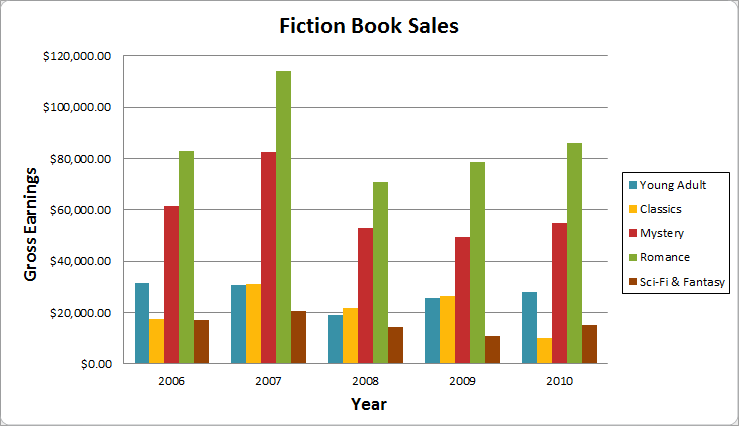
Horizontal Axis
The horizontal axis (also known as the x axis) is the horizontal part of the chart.
In this example, the horizontal axis identifies the categories in the chart, so it is also called the category axis. However, in a bar chart, the vertical axis would be the category axis.
Legend
The legend identifies which data series each color on the chart represents. For many charts it is crucial, but for some charts it may not be necessary and can be deleted.
In this example, the legend allows the viewer to identify the different book genres in the chart.
Data Series
The data series consists of the related data points in a chart. If there are multiple data series in the chart, each one will have a different color or style. Pie charts can only have one data series.
In this example, the green columns represent the Romance data series.
Title
The title should clearly describe what the chart is illustrating.
Vertical Axis
The vertical axis (also known as the y axis) is the vertical part of the chart.
In this example (a column chart), the vertical axis measures the height, or value of the columns, so it is also called the value axis. However, in a bar chart, the horizontal axis would be the value axis.
Inserting charts
PowerPoint uses a spreadsheet as a placeholder for entering chart data, much like Excel. The process of entering data is fairly simple, but if you are unfamiliar with Excel you might want to review our Excel 2013 Cell Basics lesson.
To insert a chart:
- Select the Insert tab, then click the Chart command in the Illustrations group.
 Clicking the Chart command
Clicking the Chart command - A dialog box will appear. Select a category from the left pane, and review the charts that appear in the right pane.
- Select the desired chart, then click OK.
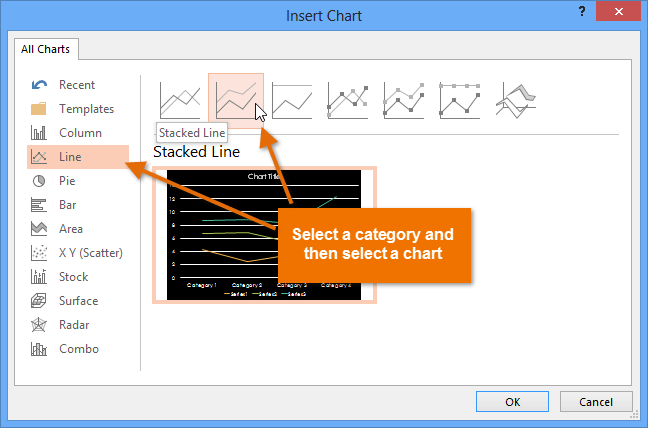 Choosing a chart type
Choosing a chart type - A chart and a spreadsheet will appear. The data that appears in the spreadsheet is placeholder source data you will replace with your own information. The source data is used to create the chart.
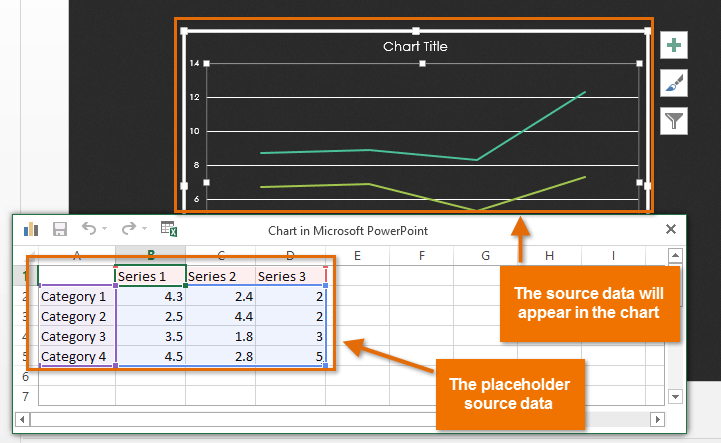 The placeholder source data and the corresponding chart
The placeholder source data and the corresponding chart - Enter data into the worksheet.
 Entering data into the worksheet
Entering data into the worksheet - If necessary, click and drag the lower-right corner of the blue line to increase or decrease the data range for rows and columns. Only the data enclosed by the blue lines will appear in the chart.
 Dragging the blue line to decrease the data range
Dragging the blue line to decrease the data range - When you're done, click the X to close the spreadsheet.
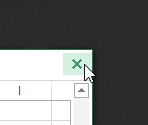 Closing the worksheet
Closing the worksheet - The chart will be completed.
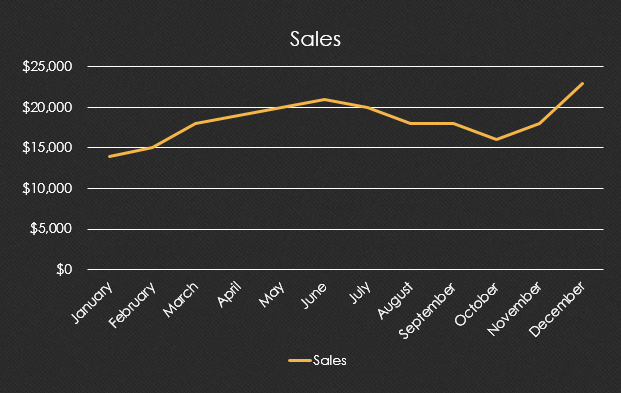 The completed chart
The completed chart
You can edit the chart data at any time by selecting your chart and clicking the Edit Data command on the Design tab.
 Clicking the Edit Data command
Clicking the Edit Data commandYou can also click the Insert Chart command in a placeholder to insert a new chart.
 Insering a chart from a placeholder
Insering a chart from a placeholderCreating charts with existing Excel data
If you already have data in an existing Excel file that you would like to use for a chart, you can transfer the data by copying and pasting it. Just open the spreadsheet in Excel, select and copy the desired data, and paste it into the source data area for your chart.
You can also embed an existing Excel chart into your PowerPoint presentation. This may be useful when you know you'll need to update the data in your Excel file and would like the chart to automatically update whenever the Excel data is changed.
Read our guide on Embedding an Excel Chart for more information.
Modifying charts with chart tools
There are many other ways to customize and organize your charts. For example, PowerPoint allows you to change the chart type, rearrange a chart's data, and even change the layout and style of a chart.
To change the chart type:
If you find that your data isn't well-suited to a certain chart, it's easy to switch to a new chart type. In our example, we'll change our chart from a line chart to a column chart.
- Select the chart you want to change. The Design tab will appear on the right side of the Ribbon.
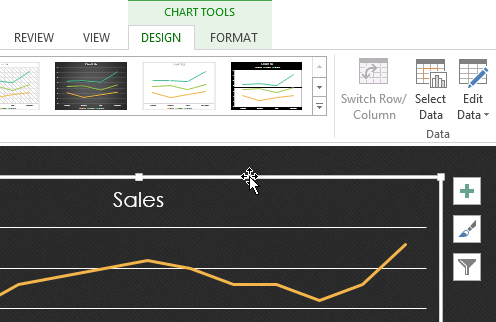 Selecting a chart
Selecting a chart - From the Design tab, click the Change Chart Type command.
 Clicking the Change Chart Type command
Clicking the Change Chart Type command - A dialog box will appear. Select the desired chart type, then click OK.
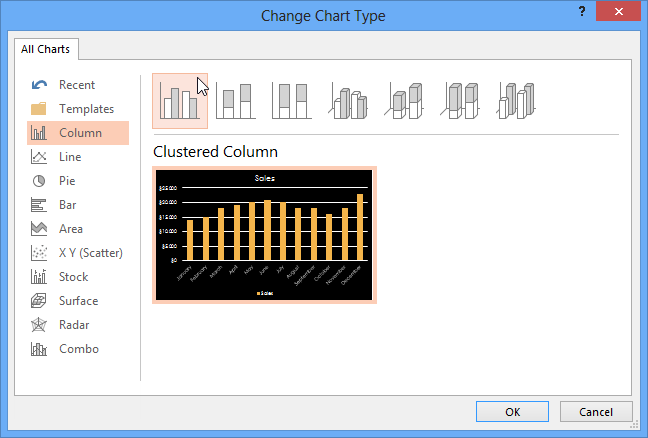 Choosing a new chart type
Choosing a new chart type - The new chart type will appear.
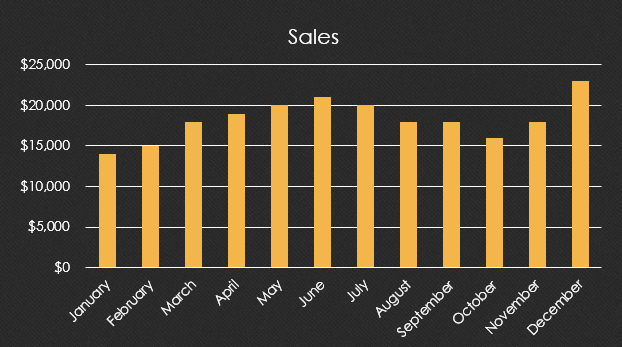 The new chart type
The new chart type
To switch row and column data:
Sometimes you may want to change the way charts group your data. For example, in the chart below the book sales data is grouped by genre, with columns for each year. However, we could switch the rows and columns so the chart will group the data by year, with columns for each genre. In both cases, the chart contains the same data—it's just organized differently.
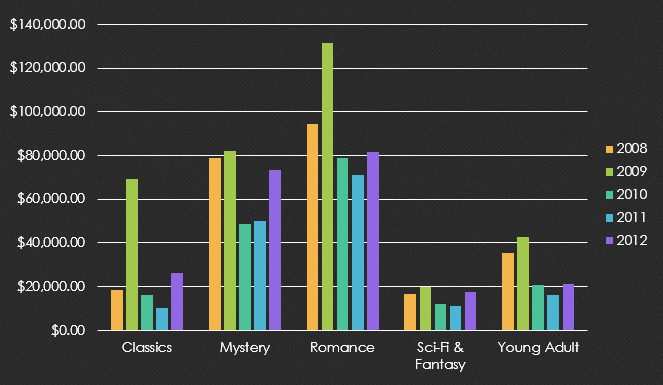 The data grouped by genre, with columns for each year
The data grouped by genre, with columns for each year- Select the chart you want to modify. The Design tab will appear.
- From the Design tab, select the Edit Data command in the Data group.
 Clicking the Edit Data command
Clicking the Edit Data command - Click the chart again, then select the Switch Row/Column command in the Data group.
 Clicking the Switch Row/Column command
Clicking the Switch Row/Column command - The rows and columns will be switched. In our example, the data is now grouped by year, with columns for each genre.
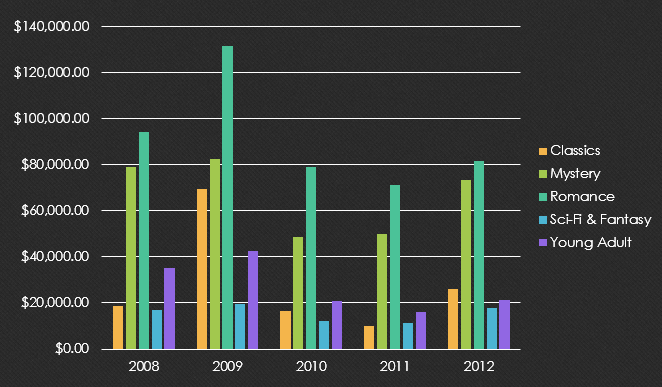
The data grouped by year, with columns for each genre
We've noticed that when numerical data has been entered in the first column of the spreadsheet, switching rows and columns may cause unexpected results. One solution is to type an apostrophe before each number, which tells the spreadsheet to format it as text (instead of a numerical value). For example, the year 2013 would be entered as '2013.
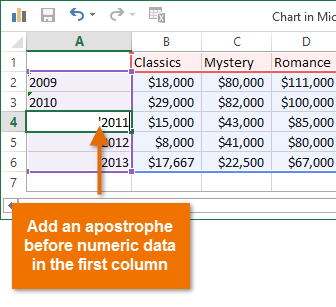 Adding an apostrophe before numeric data
Adding an apostrophe before numeric dataTo change the chart layout:
Predefined chart layouts allow you to modify chart elements—including chart titles, legends, and data labels—to make your chart easier to read.
- Select the chart you want to modify. The Design tab will appear.
- From the Design tab, click the Quick Layout command.
 Clicking the Quick Layout command
Clicking the Quick Layout command - Select the desired predefined layout from the menu that appears.
 Selecting a layout
Selecting a layout - The chart will update to reflect the new layout.
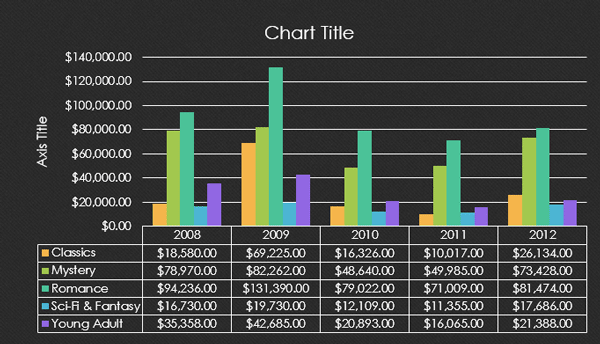 The new chart layout
The new chart layout
To change a chart element (such as the chart title), click the element and begin typing.
 Changing the chart title
Changing the chart titleTo change the chart style:
Chart styles allow you to quickly modify the look and feel of your chart.
- Select the chart you want to modify. The Design tab will appear.
- From the Design tab, click the More drop-down arrow in the Chart Styles group.
 Clicking the More drop-down arrow
Clicking the More drop-down arrow - Select the desired style from the menu that appears.
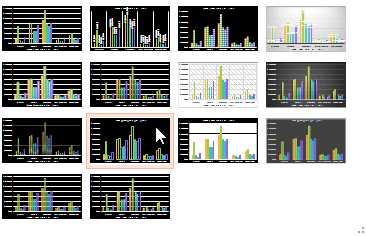 Choosing a new chart style
Choosing a new chart style - The chart will appear in the selected style.
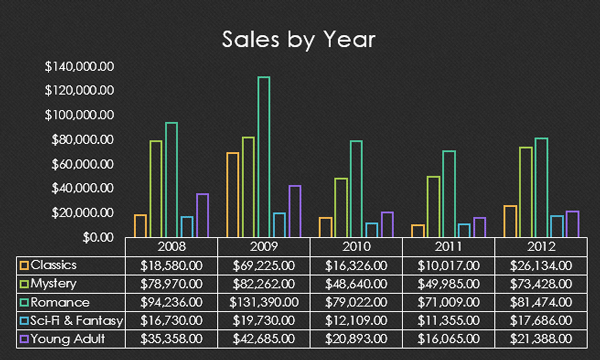 The new chart style
The new chart style
You can also use the chart formatting shortcut buttons to quickly add chart elements, change the chart style, and filter the chart data.
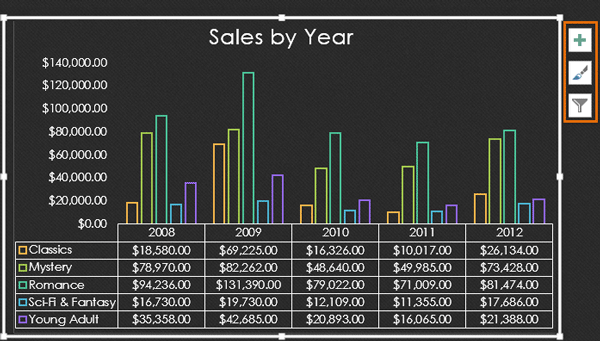 Chart formatting shortcuts
Chart formatting shortcutsChallenge!
- Open an existing PowerPoint presentation. If you want, you can use our practice presentation for this lesson.
- Insert a new chart or edit an existing one. If you're using the example, edit the chart on slide 4 by deleting data for 2008.
- Try changing the chart type and layout.
- Switch the row and column data.
- Apply a chart style. If the new style includes a chart title or any labels, edit those.





